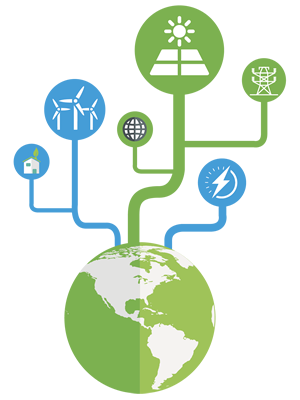Start Here
Skip to:
About
The About tab is a great starting point for anyone new to Greening the Grid. It provides high-level information on the purpose of the platform and the topics covered in the five toolkits: Grid Integration, Distributed Photovoltaics (DPV), Renewable Energy Zones (REZ), Electric Vehicle (EV), and Energy Storage. You will see this information on the About landing page, and in the fact sheet on the left side of the page. The Featured Links page directs you to the websites of partners, tools, and platforms that are associated with Greening the Grid or provide supplementary information. The Glossary page is useful specifically for users who are new to energy systems topics and provides explanations of both common and technical energy terms.
Ask An Expert
This page serves as a hotline for technical energy questions. Users can click on the Submit a Request button on the left navigation panel to submit a question or request to an energy expert. This page will connect users with experts on renewable energy integration, with deep understanding of technical, policy, and regulatory issues. In general, the Ask an Expert service is intended to provide high-level guidance. For more in-depth support beyond the scope of this service, please contact us.
The network of experts consists of staff and researchers at the National Renewable Energy Laboratory. Additionally, Greening the Grid partners with the Clean Energy Solutions Center and its associated Clean Energy Grid Integration Network (CEGIN), which offer customized technical assistance to countries in strengthening clean energy grid integration policies and regulations.
Toolkits
This tab is where most resources on Greening the Grid can be found. These resources are categorized by topic area and into toolkits. These toolkits are:
- Grid Integration
- Distributed Photovoltaics (DPV)
- Renewable Energy Zones (REZ)
- Electric Vehicle (EV)
- Energy Storage
Generally, navigation across all toolkits will be a similar experience: click on the desired toolkit by hovering over the Toolkits tab at the top, or by clicking on the desired toolkit when you’re on the Toolkits landing page. Each toolkit page will have Quick Links listed on the left navigation panel, providing more in-depth information and resources about the toolkit. These subtopics are replicated in the top navigation bar for convenient navigation. To back out of a toolkit page, just click on the Greening the Grid logo in the header at the top of the page. This will bring you back to the main page of the site.
Grid Integration Toolkit
When clicking on certain Quick Links, they expand to reveal a deeper dive into the subtopic. For example, under the Quick Reads subtopic, you will find Fact Sheets, which is a one-stop shop for all published fact sheets related to Grid Integration. Topics & Resources provides overviews and further reading resources to a variety of Grid Integration topics. Finally, Trainings is a repository for recorded webinars on the topic.
Distributed Photovoltaics (DPV) Toolkit
Like Grid Integration, the DPV Toolkit has Quick Reads, Topics & Resources, and Trainings as Quick Links on the left navigation panel and top navigation bar. In addition to these, this toolkit hosts an Analysis Guide. This guide provides a framework of questions and considerations to inspire productive and realistic analysis of unique considerations for the user’s country. The Tools & Templates subtopic provides links to tools that may be useful to decision-makers to analyze and understand DPV issues. Finally, Pilot Projects is a case study collection of USAID-NREL projects to share best practices, build capacity, and provide technical assistance to accelerate DPV deployment around the world.
Renewable Energy Zone (REZ) Toolkit
The REZ Toolkit will look familiar, with Quick Links to Quick Reads, REZ Guidebook, Topics & Resources, Tools & Templates, and Trainings. The REZ Guidebook provides a step-by-step process for decision-makers and planners to chart expansion of their transmission networks and overcome barriers of traditional transmission planning approaches. This includes Process Design and Vision Statement, Renewable Energy Resource Assessment, Candidate Zones Selection, Transmission Options Development, and Final Transmission Plan Designation.
Electric Vehicle (EV) Toolkit
Like the others, the EV Toolkit consists of Quick Reads, Topics & Resources, Tools & Templates, Trainings, an Electric Vehicle Deployment Guidebook, and Pilot Projects. The Guidebook provides a holistic and actionable framework for policymakers, regulators, and other decision makers in developing countries for how to plan, implement, and scale EV deployment in their jurisdictions. This is done by outlining several “Building Blocks”: Targets and Incentives, Data Management, Charging Infrastructure, EVSE Standards and Communications, Grid Planning and Management, Tariff Design, and Workforce Development.
Energy Storage Toolkit
Browse Quick Reads, Topics & Resources, Tools & Templates, Trainings, and Pilot Projects for more resources on energy storage. The Topics & Resources page is useful if you are looking for more information on storage technology, grid services and value stacking of storage, markets and regulation, grid codes, interconnection and safety, and procurement, financing, and business models for energy storage integration.
News and Events
Here you will find information on upcoming events, and the latest published materials, including new reports, papers, fact sheets, webinars, across all the topics covered on Greening the Grid.
Where We Work
Greening the Grid, through support from USAID and expertise from NREL, provides guidance, technical assistance, and capacity building on renewable energy grid integration topics around the world. In this tab you can find specific examples of projects executed with in-country partners in Asia, Africa, and South America.
Trainings and Resources
All webinars found under any of the five toolkits can also be found in the trainings page, and all the fact sheets, papers, and other resources like featured links, references, and glossary can be found in the Resources page.


